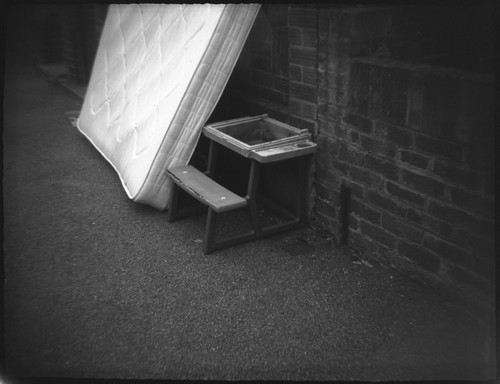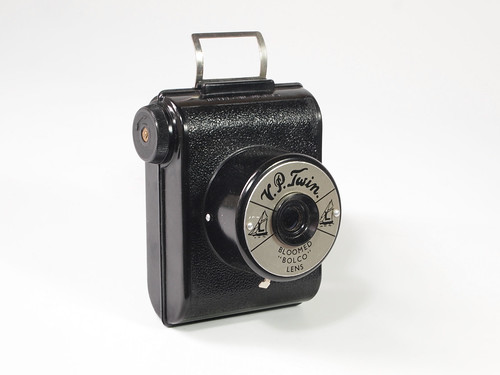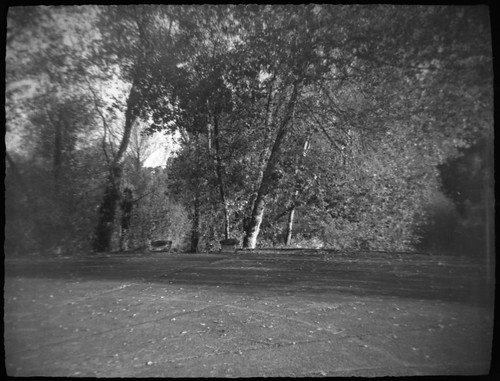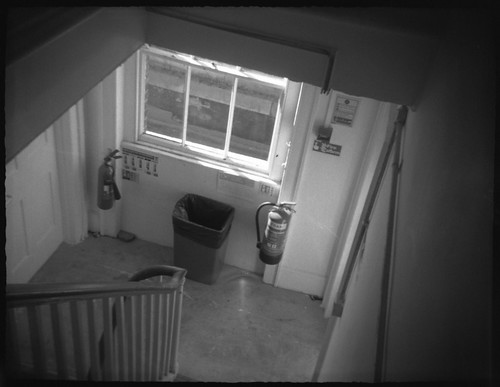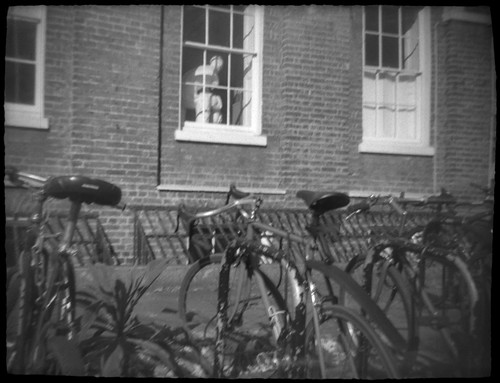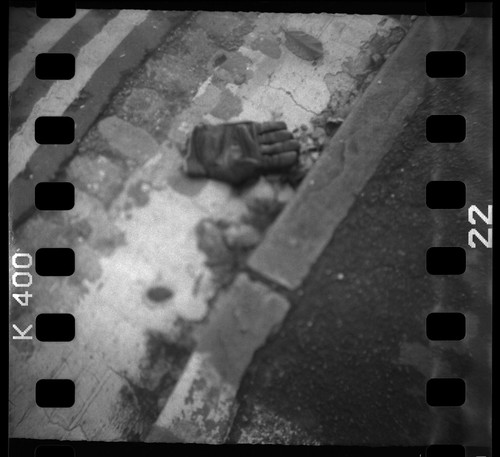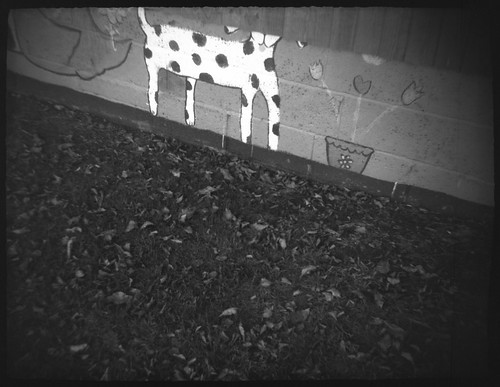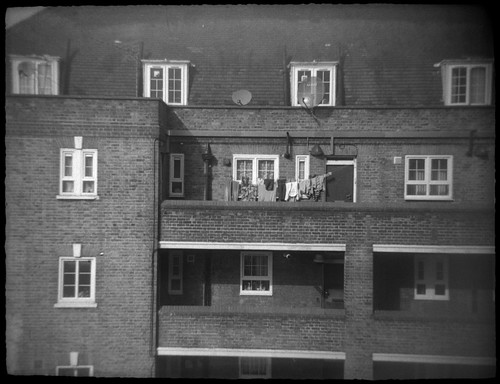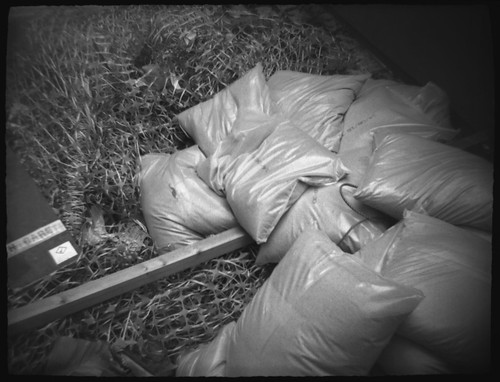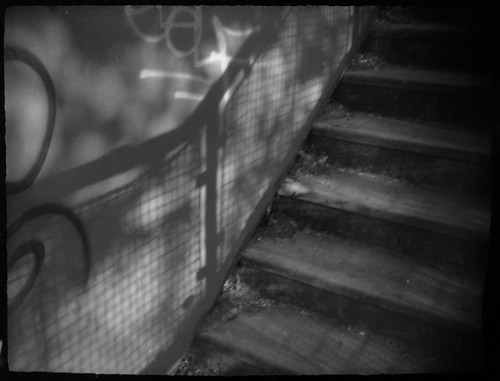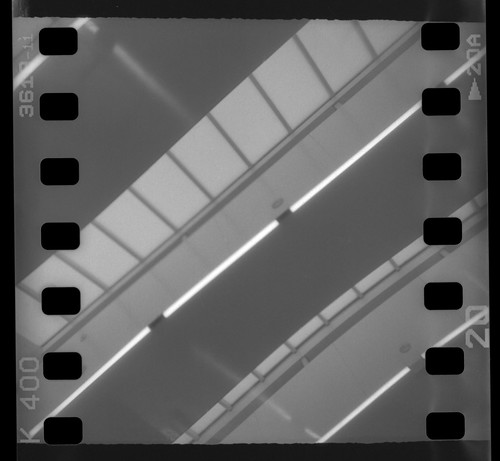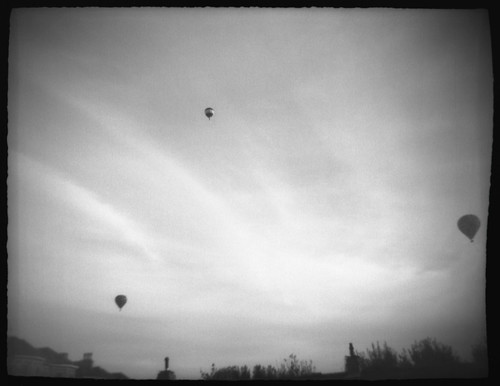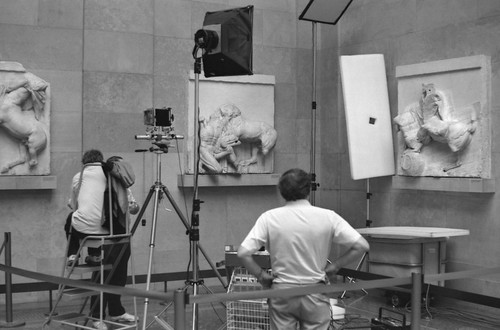 |
| First roll of Ilford XP2, shot with Praktica BCA, July 1994 |
In my previous post, part one of
Ilford XP2 Super, I revisited a film that I had used more than any other for a few years when I didn't have access to a darkroom, and had my interest rekindled by buying a cheap batch of just-out-of-date film. The current version of Ilford's chromogenic film, Ilford XP2 Super, is twenty years old this year; I had first used the previous named iteration of the film, XP2, in 1994 (it was 'updated' in 1996 with no name change to indicate this); in the course of my research for writing about the film, I scanned some of the negatives and prints from the first photographs I'd taken with Ilford XP2, but decided that some of that material would be better as a separate post, with a more personal reflection on using the film; at the same time, in the interval, I also had the chance to make some prints in the darkroom from some of the tests I had shot for the first post.
In part one, I made two sets of latitude tests, and compared Ilford XP2 Super processed as C41 to that using a traditional black and white film developer. Those comparisons were made from assessing the contact sheets and scans from negatives, but I did feel that I should also make a comparison with printing from the negatives. This confirmed my first results, but perhaps the differences were even more marked. All the prints I made used Kentmere VC Select paper without using Multigrade contrast filters, thereby rendering the paper at a grade 2 contrast: this appeared to be ideal for
neither set of negatives - too low in contrast for the C41 negatives, too high for the black and white developed ones.
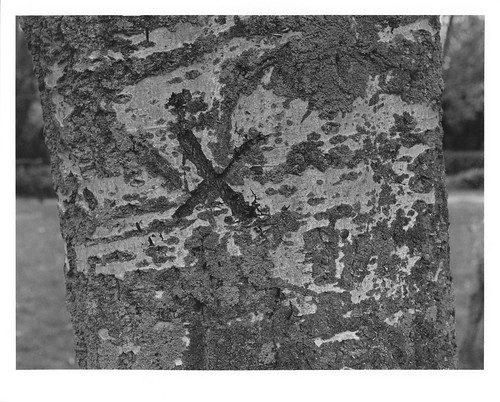 |
| Ilford XP2 Super, rated EI 400, C41 process |
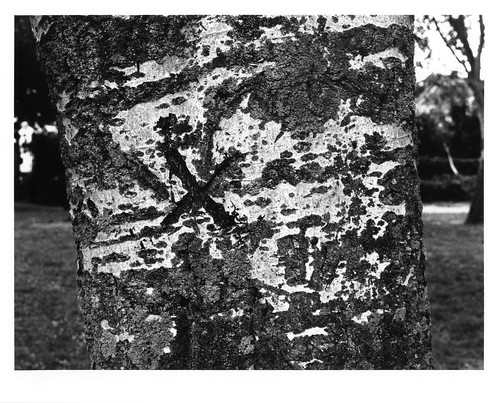 |
| Ilford XP2 Super, rated EI 400, developed in Fomadon R09 |
The comparisons when rating the film as low as 50 varied even more. As Ilford suggest with XP2 Super, it can be rated at EI 50 for 'finest grain'; this also reduces the contrast further. Developed in R09, essentially the opposite effect is achieved: the appearance of grain is more prominent and the highlights start losing detail, adding to contrast.
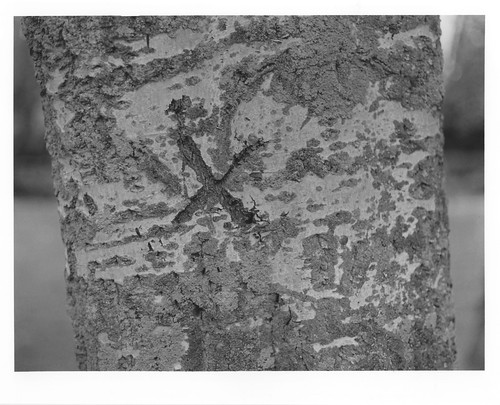 |
| Ilford XP2 Super, rated EI 50, C41 process |
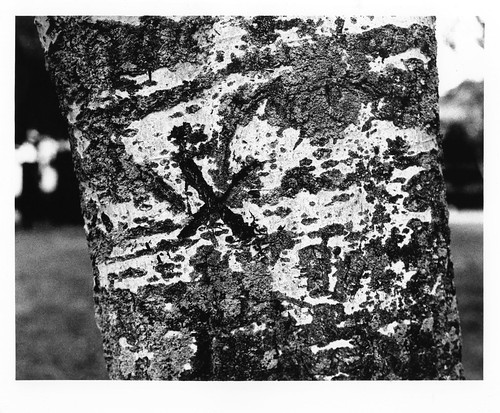 |
| Ilford XP2 Super, rated EI 50, developed in Fomadon R09 |
As the scans from the negatives seemed to indicate, from making prints in the darkroom, the practice of rating the film at EI 50 for 'finest grain' does also appear to reduce sharpness; there is nothing to be gained in rating the film at EI 50 if developing it in black and white chemicals - the best results I achieved were at exposure indexes of 200-400. The grain with black and white chemicals was fairly consistent, perhaps even a little more apparent grain than one might expect with a 400 ISO film, but this might be more prominent due to the relatively high contrast of the images, which in itself exaggerates grain.
As I wrote in the previous post, one of the chief advantages of using XP2 is that, as it is designed for the C41 process, it can be developed at any lab that processes colour negative film, and so it would be possible to produce proof prints for a whole roll of film in an hour. However, in my experience from using XP2 over many years, relying on the standard C41 lab prints, the results would often vary widely. When I first used XP2, I would take it to Boots for developing; generally, they used to provide very warm sepia prints, at least in the 1990s. Later, using Kodak processing via a big supermarket chain, I would often receive prints with much cooler colours in a blue-tinted monochrome. Sometimes though, the prints from a lab would come back with a colour cast varying from orange to green to magenta across a single print as in the example below; sometimes shop prints might have as good as no detail in the highlight areas, or, more commonly in my experience, the midtones and shadows might be compressed.
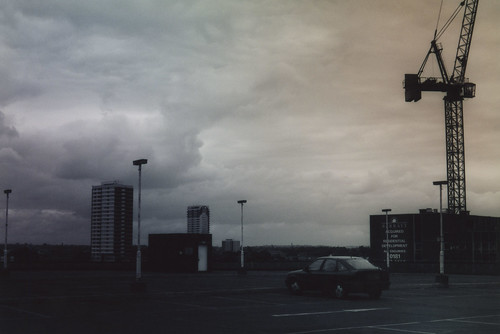 |
| Ilford XP2 Super - scan from lab print |
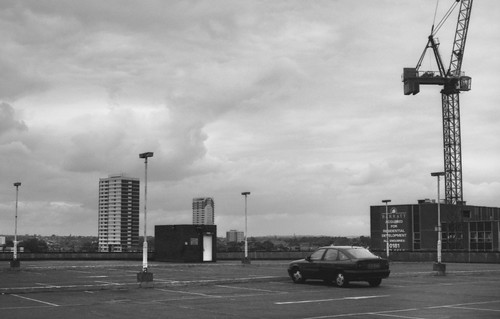 |
| Ilford XP2 Super - scan from negative |
At the time that I was using Ilford XP2 regularly, I often used the resulting lab prints as reference material to make paintings from. To begin with, these were often from enlarged photocopies, then from scans of the prints, which at times became quite elaborate, sometimes numerous photographs joined together in a seamless fashion digitally as a basis for the more complicated paintings that I was doing. As can be appreciated from the comparison above, the variations in the prints do make a large difference - the print has very little shadow detail, and the colour cast also affects tonal relationships - and as such, this could be a problem when working from lab prints. Scanning from the negative above has pulled out all the available shadow detail, while retaining the modelling in the sky, producing a much more usable image.
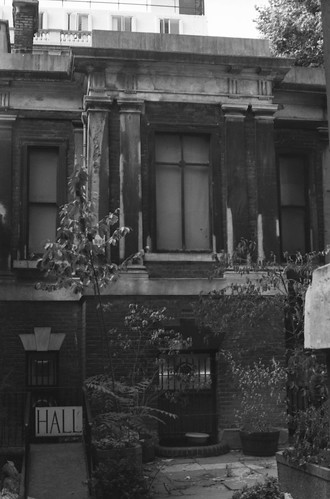 |
| First roll of Ilford XP2, shot with Praktica BCA, July 1994 |
In the summer of 1994, I bought a secondhand Praktica camera body - a BCA for £26, my second 35mm SLR camera, which would be my main camera until I replaced it with a
Canon A-1 in 2001 (it was my only SLR, which was later supplemented by a
Zeiss Ikoflex Ic, an
Olympus Pen EE3 and a
Kodak No.2 Brownie). The reason for buying a Praktica BCA was, as well as being cheap, that I already had a lens from my previous 35mm SLR, a Praktica BC1, as written about in the post
Twenty Years Since. That summer, with my new-to-me Praktica BCA, between college courses and without access to a darkroom, I could get XP2 developed for the same price as colour film and with the same turnover time, in comparison to normal black and white film, which I'd just started to use over the previous few months. Ilford XP2's other distinct characteristics - its fine grain for a fast film, its latitude - were not considerations at the time: cost and convenience were the main reasons for choosing it. There were two photographs on XP2 from that summer which I still have as both the original lab prints, and as prints I'd made myself in the darkroom a year later; from the negatives, I made scans of these as a point of comparison to the two very different prints.
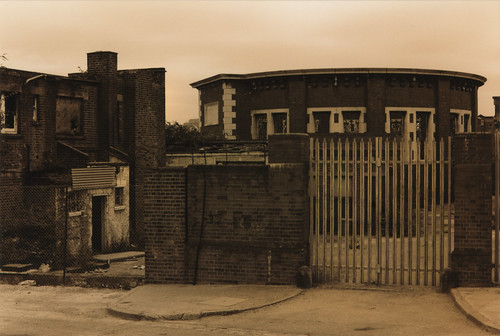 |
| Praktica BCA with Ilford XP2, scan from lab print |
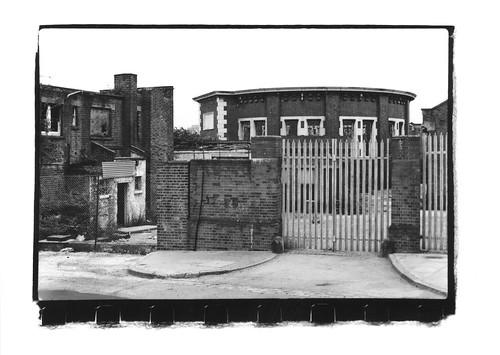 |
| Scan from print on Jessops VC paper |
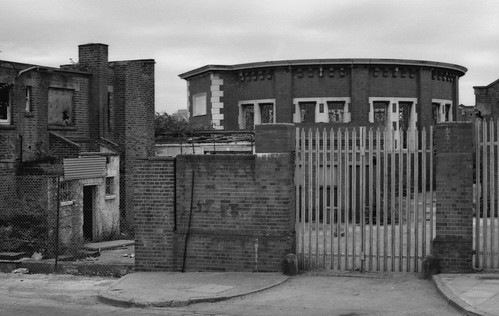 |
| Scan from negative |
In the original lab prints, the low contrast of the XP2 negatives appears to be a little problematic: detail in the highlights is retained, while compromising the relationship of the mid-tones to the shadow areas. However, I do remember that I liked the sepia effect of the monochrome prints on colour paper, and this was something I used in a number of collages I made at the time, incorporating these prints. These were from the first rolls of XP2 that I shot, and I didn't experience the variability that was possible in lab prints of the film until some years later.
I had used significantly more contrast in the darkroom prints made in 1995, and, although I was probably happy with the results then, I am less keen on the blank skies now, and would probably try to retain detail through burning or split grade printing, or a combination of both. I had also made my own negative carrier in order to show the edges of the negative and a part of the perforations at the bottom edge of the image, something I now think of as an affectation - no doubt I had seen this effect in a book and had wanted to emulate it. The darkroom print from the photograph below is squared up with a grid to use the image as reference for a painting - and subsequently used for a second painting, too. Coincidentally, this location with the gasholder was photographed for the cover of the Tyrrel Corporation's single 'You're Not Here' with the two band members sitting on the low wall in front of the arch. The single was released in 1994 and I remember flyposters advertising it on hoardings in Ilford town centre around the time I took my photograph below: also, coincidentally, the cover of the single and the images on the posters happened to be in sepia.
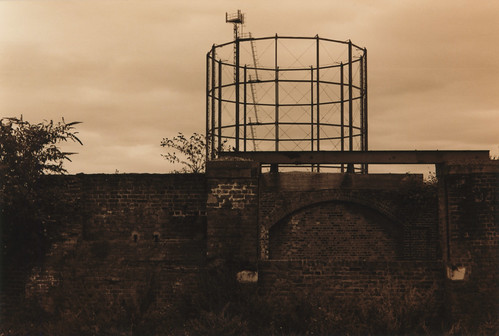 |
| Praktica BCA with Ilford XP2, scan from lab print |
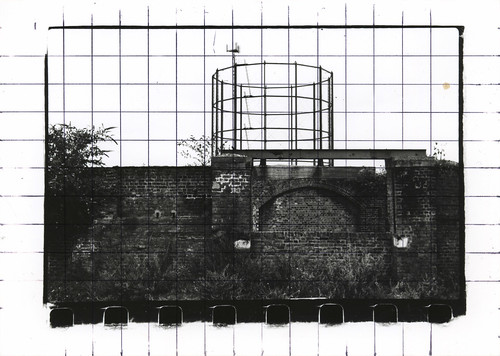 |
| Scan from print on Jessops VC paper |
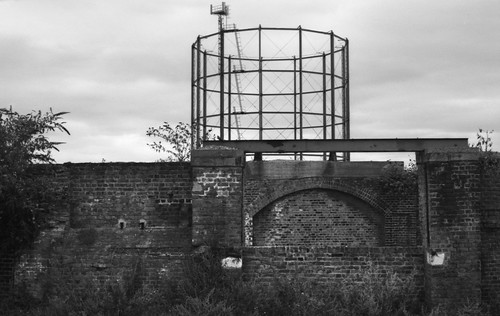 |
| Scan from negative |
After scanning the original negatives of these two photographs alongside the two different prints, I had the idea to revisit these two locations this summer, to photograph them again on Ilford XP2 Super, twenty-four years to the day. I had thought that these images had come from my first roll of Ilford XP2, but, on closer inspection of the dates and diary entries, these turned out to be from my
second roll of the film. The first had been shot over the preceding two weeks, including the shot at the top of this post, but I did get both rolls processed at the same time - at Boots in Ilford, of all places - I had handed in the first roll beforehand, to Jessops I believe, but they returned the film undeveloped, telling me that they couldn't process it (perhaps they had been thinking of XP1, which had its own developer), at which point I took the two rolls to Boots: Ilford XP2 provided them without any difficulties, and I had Boots process a few more rolls of film after that.
As I no longer have my Praktica BCA, I used a Zenit 11 in order to shoot with a screw-mount 50mm f1.8 Prakticar lens - the same lens as used on the BCA (which would have been a Praktica bayonet mount of course, but the lens
design would be the same; at the time I only had the standard 50mm lens; later I would get a 28mm and a 70-210mm zoom). The weather twenty-four years ago had been overcast (my darkroom prints made a year later simply omitted the cloud detail in the negative through using high contrast filters); shooting the same subjects this summer, at the tail end of the longest heatwave for forty-two years in England, the weather was unfailingly sunny.
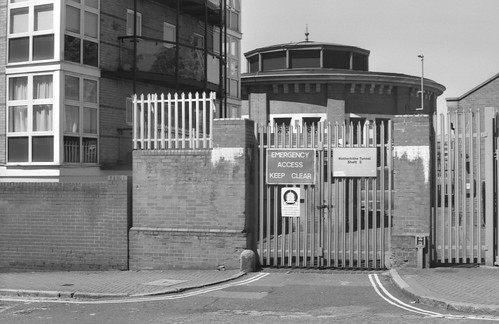 |
| Rotherhithe, August 2018; Zenit 11 with Ilford XP2 Super |
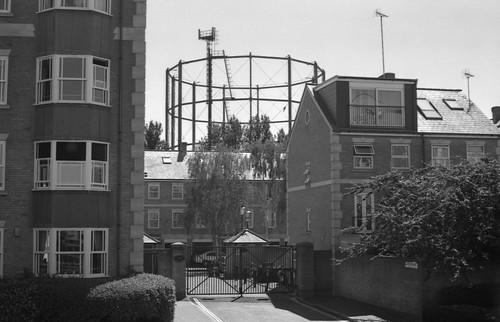 |
| Rotherhithe, August 2018; Zenit 11 with Ilford XP2 Super |
The subjects of the two photographs from 1994 which appear in the lab and darkroom prints are only a few metres apart, on the south of the river Thames in Rotherhithe; the first shows the southern ventilation shaft to the Rotherhithe Tunnel. The shaft building itself remains, although this now has a roof; the gate and gateposts are the same, but the outbuildings have been replaced by a newer residential block since, a process that has changed the view of the gasholder in the second photograph even more radically. By 1994 most of the operations of the London docks had moved miles further east to Tilbury, and this area alongside the Thames was in between cycles of speculative building: the boom of 'Docklands', largely on the Isle of Dogs on the other side of the river, had slowed in the wake of the recession of the early 1990s. Redevelopment of the area was restarted towards the end of the decade and into the 2000s, with the impetus of the Millennium Dome and improved transport links, as well as the general economic climate of the time.
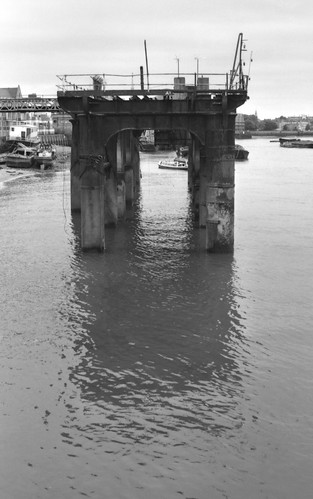 |
| Rotherhithe, August 1994; Praktica BCA with Ilford XP2 |
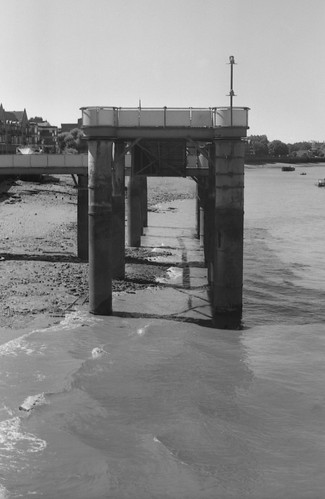 |
| Rotherhithe, August 2018; Zenit 11 with Ilford XP2 Super |
Discovering photography and exploring London went hand in hand, and I would return to these areas a number of times in subsequent years, shooting in medium format when I bought my
Ikoflex Ic a couple of years later. This was an area relatively close to where I had been attending college in east London earlier in 1994, a couple of stops down on the old East London line on the Underground from Whitechapel. Its proximity was one attraction; the other was the sense of abandonment - that there were still second world war bomb sites in London that hadn't been built on, fifty years after the end of the war - and the mild illicit thrill of climbing through holes in fences or over walls to take some of these photographs. One particular location that I photographed on Ilford XP2 in 1994, on the other side of the river from Rotherhithe, in Wapping, was that of Watson's Wharf on Hermitage Wall. This had been derelict since the war; it had been the site of a large air raid shelter which had also been the base of the 'Dead End Kids', local teenagers organised into a group of unofficial air raid wardens and firefighters, some of whom had been killed while on duty. Local residents had wanted to turn the whole site into a memorial garden to commemorate Londoners who had died in the Blitz; around the time I had photographed it, the site had then been recently sold to the London Docklands Development Corporation and there were notices from a group called Civilians Remembered along the railings and fences around the site. The building seen side on in the photograph from 1994 below marks what would have been the boundary of the proposed memorial garden. In the photograph from this year, it can been seen face on, behind the tree, just to the left of centre: the foreground of the first photograph is now built over with the large block of apartments that takes up the whole left hand side of the second photograph.
 |
| Watson's Wharf, Wapping, August 1994; Praktica BCA with Ilford XP2 |
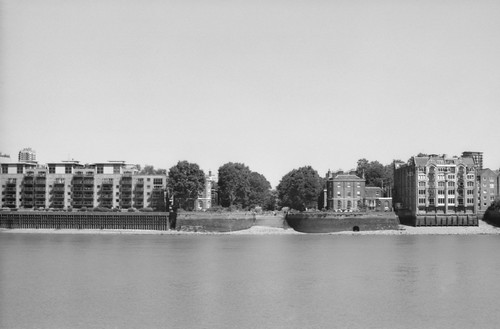 |
| View of Wapping, August 2018; Zenit 11 with Ilford XP2 Super |
